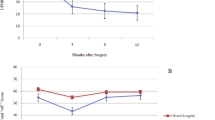Abstract
With the exception of thalamotomy for drug-refractory tremor, surgical therapy for Parkinson’s disease has been almost abondoned as treatment for Parkinsonian symptoms between 1965 and 1985. Reasons for this development relate to inconsistent postoperative results, complications associated with stereotactic surgical techniques and, most importantly, the advent of levodopa, which is still considered to be the gold standard in pharmacotherapy for Parkinson’s disease. However, both, the long-term experience with L-DOPA therapy on the one hand and the progress of advanced stereotactic techniques and fetal graft research on the other hand have lead to reconsideration of surgical therapy in Parkinson’s disease for patients, who can not be treated satisfactorily with medication. Both lesions (via thermocoagulation) and/or neurostimulation (via chronic intracerebral implantation of electrodes) in thalamic nuclei (nucleus ventralis oralis posterior/intermedialis thalami; VOP/VIM) may alleviate rest tremor in PD patients. In principle neurostimulation has the significant advantage of reversibility with regard to side effects in comparison to lesion surgery. Furthermore ventro-posterior pallidotomy or chronic stimulation in this structures may ameliorate bradykinesia and levodopa-induced dyskinesias. Additionally, ”switching-off” the subthalamic nucleus by neurostimulation has been reported to reduce rigidity, bradykinesia and levodopa-induced ON-OFF-fluctuations. On the other hand, neuronal transplantation of fetal nigral dopamine precursor cells aims at restoring the striatal dopamine deficit. Both animal and clinical experiments have shown that fetal grafts survive intrastriatal transplantation and may ensue moderate to satisfactory improvements, especially in regard to bradykinesia and ON-OFF-fluctuations. Further progress in the field of neuronal transplantation will largely depend on the development of alternative cell resources.
Similar content being viewed by others
Author information
Authors and Affiliations
Rights and permissions
About this article
Cite this article
Kupsch, A., Earl, C. Neurosurgical interventions in the treatment of idiopathic Parkinson disease: neurostimulation and neural implantation. J Mol Med 77, 178–184 (1999). https://doi.org/10.1007/s001090050332
Issue Date:
DOI: https://doi.org/10.1007/s001090050332




